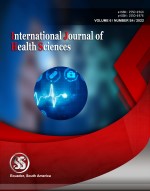Test the effectiveness of clove leaf ethanol extract on wound healing in rats
Keywords:
clove leaf extract, healing, ointmentAbstract
Clove leaves (Syzygium aromaticum (L.) Merr. & Perry) contain alkaloid compounds, flavonoids, tannins and essential oils that play a role in wound healing. This study used 20 male mice as samples divided into 4 treatment groups, namely group 1 (negative control group), group 2 (positive control group), group 3 (15% clove leaf extract ointment), and group 4 (leaf extract ointment). clove concentration 20%). All mice were injured 2 cm long. The results showed that there was a difference between the control and the clove leaf extract ointment at concentrations of 15% and 20%. In the Wilcoxon test the results showed a p value <0.05 where there was a treatment group. And for the Mann Whitney test the results showed that there were differences between the control group and the clove extract ointment. The p value for the three comparisons was only negative control with clove leaf extract ointment with a concentration of 15% and a concentration of 20% which was smaller than 0.05. So the hypothesis Ho is rejected, there is a difference between the negative control with clove leaf extract ointment with a concentration of 15% and 20%.
Downloads
References
Albert, D., Muthusekhar, M. R., Sivashanmugam, S., & Sridharan, G. (2022). Role of topical hemocoagulase in postoperative wound healing following dentoalveolar extraction: A systematic review. International Journal of Health Sciences, 6(S4), 5521–5532. https://doi.org/10.53730/ijhs.v6nS4.9340
Batiha, G. E. S. et al. (2020) ‘Syzygium aromaticum L. (Myrtaceae): Traditional Uses, Bioactive Chemical Constituents, Pharmacological and Toxicological Activities’, Biomolecules 2020, Vol. 10, Page 202, 10(2), p. 202. doi: 10.3390/BIOM10020202.
Banerjee, K. et al (2020) “ Anti immflamatory and wound healing potensial of clove oil emulsion” Colloids and surfaces B:Bio interfaces, Vol.193 doi.org/10.1016/j.colsurfb.2020.111102
Fadillah, M. and Santoso, P. (2019) ‘The sirangak (cyanthillium cinereum; asteraceae) oil accelerates sliced-wound healing by enhanching the hematological endurance in male albino mice’, Journal of Physics: Conference Series, 1317(1), p. 012080. doi: 10.1088/1742-6596/1317/1/012080.
Farha, A. K. et al. (2020) ‘Tannins as an alternative to antibiotics’, Food Bioscience, 38, p. 100751. doi: 10.1016/J.FBIO.2020.100751.
Gamez, M. R., Perez, A. V., Sera, A. S., & Ronquillo, Z. M. (2017). Renewable energy sources and local development. International Journal of Social Sciences and Humanities, 1(2), 10–19. https://doi.org/10.29332/ijssh.v1n2.31
Haro-González, J. N. et al. (2021) ‘Clove Essential Oil (Syzygium aromaticum L. Myrtaceae): Extraction, Chemical Composition, Food Applications, and Essential Bioactivity for Human Health’, Molecules 2021, Vol. 26, Page 6387, 26(21), p. 6387. doi: 10.3390/MOLECULES26216387.
Haryani, D. 2015. Berkumur ekstrak Daun Cengekh (Eugenia aromaticum) 4% Dapat Menurunkan Jumlah Koloni Bakteri dan Bakteri Staphylococcus Aureus pada abses Submukus,Tesis, Program Pasca Sarjana Universitas Udayana, Bali
Kim, Y. S. et al. (2011) ‘Therapeutic Effect of Total Ginseng Saponin on Skin Wound Healing’, Journal of Ginseng Research, 35(3), p. 360. doi: 10.5142/JGR.2011.35.3.360.
Mahmood, A. et al. (2016) ‘Triterpenoid saponin-rich fraction of Centella asiatica decreases IL-1ß andNF-?B, and augments tissue regeneration and excision wound repair’, Turkish Journal of Biology, 40(2), pp. 399–409. doi: 10.3906/biy-1507-63.
Ningtyas, G. 2017. Uji Efektivitas Ekstrak Rimpang Kunyit (Curcuma Domestica Val) Dalam Mempercepat Proses Penyembuhan Luka Sayat Pada Mencit (Mus Musculus) Jantan. Fakultas Kedokteran Universitas Muhammadiyah Surakarta
Perdanakusuma D. S. 2007. Anatomi Fisiologi Kulit dan Penyembuhan Luka. Surabaya: Airlangga University School of Medicine, Surabaya.
Pires, M. A. et al. (2020) ‘Sensorial Perception of Astringency: Oral Mechanisms and Current Analysis Methods’, Foods 2020, Vol. 9, Page 1124, 9(8), p. 1124. doi: 10.3390/FOODS9081124.
Qomariah, S. 2014. Efektivitas Salep Ekstrak Batang Patah Tulang (Euphorbia Tirucalli) Pada Penyembuhan Luka Sayat Tikus Putih (Rattus Norvegicus). Fakultas Matematika Dan Ilmu Pengetahuan Alam Universitas Negeri Semarang.
Shin, M. et al. (2018) ‘Targeting protein and peptide therapeutics to the heart via tannic acid modification’, Nature Biomedical Engineering 2018 2:5, 2(5), pp. 304–317. doi: 10.1038/s41551-018-0227-9.
Su, X. et al. (2017) ‘Wound-healing promoting effect of total tannins from Entada phaseoloides (L.) Merr. in rats’, Burns, 43(4), pp. 830–838. doi: 10.1016/J.BURNS.2016.10.010.
Suryasa, I. W., Rodríguez-Gámez, M., & Koldoris, T. (2022). Post-pandemic health and its sustainability: Educational situation. International Journal of Health Sciences, 6(1), i-v. https://doi.org/10.53730/ijhs.v6n1.5949
Wahyuningsih, S. Soemardji, A.A. & Febiyanti, D. 2006. Efek Gel Lidah Buaya (Aloe barbadensis Mill ) Terhadap Penyembuhan Luka Bakar EksperimenPada Tikus Wister Betina.
Tsala, D. E., Amadou, D. and Habtemariam, S. (2013) ‘Natural wound healing and bioactive natural products’, Phytopharmacology, 2013(3), pp. 532–560.
Published
How to Cite
Issue
Section
Copyright (c) 2022 International journal of health sciences

This work is licensed under a Creative Commons Attribution-NonCommercial-NoDerivatives 4.0 International License.
Articles published in the International Journal of Health Sciences (IJHS) are available under Creative Commons Attribution Non-Commercial No Derivatives Licence (CC BY-NC-ND 4.0). Authors retain copyright in their work and grant IJHS right of first publication under CC BY-NC-ND 4.0. Users have the right to read, download, copy, distribute, print, search, or link to the full texts of articles in this journal, and to use them for any other lawful purpose.
Articles published in IJHS can be copied, communicated and shared in their published form for non-commercial purposes provided full attribution is given to the author and the journal. Authors are able to enter into separate, additional contractual arrangements for the non-exclusive distribution of the journal's published version of the work (e.g., post it to an institutional repository or publish it in a book), with an acknowledgment of its initial publication in this journal.
This copyright notice applies to articles published in IJHS volumes 4 onwards. Please read about the copyright notices for previous volumes under Journal History.
















